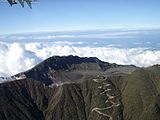Cartago Province
Province of Cartago
Provincia de Cartago | |
|---|---|
 Location of the Province of Cartago | |
| Coordinates: 9°48′N 83°39′W / 9.800°N 83.650°W | |
| Country | Costa Rica |
| Capital city | Cartago |
| Area | |
| • Total | 3,124.67 km2 (1,206.44 sq mi) |
| Population (2011)[2] | |
| • Total | 490,903 |
| • Density | 160/km2 (410/sq mi) |
| Demonym | Cartaginés |
| ISO 3166 code | CR-C |
Cartago is a province of Costa Rica. It is in the central part of the country. The provincial capital is the city of Cartago.
Location
[change | change source]The Cartago province is a landlocked province (it does not border the ocean) and is bordered on the east and north by the Limón province and on the south and west by the San José province.[1]
Geography
[change | change source]Cartago is the second smallest province of Costa Rica, only the Heredia province is smaller. It has an area of 3,124.67 km2 (1,206.44 sq mi).[1]
There are two mountain ranges in the province: the Cordillera Central ("Central mountain range"), also known as Volcanic Central mountain range, and the Talamanca mountain range.
There are several volcanoes in the province; among them are the Irazú, 3,432 m (11,260 ft) high, and the Turrialba, 3,340 m (10,960 ft) high.[1]
Some rivers in the province are Reventado, Reventazón, Palomo, Grande de Orosi, Macho, Tiribí, Chirripó, Tuis and Pejibaye.[3]
Demographics
[change | change source]A person from the province is known as cartaginés (woman: cartaginesa).[3]
The Cartago province had a population, in 2011, of 490,903 for a population density of 157.1 inhabitants/km2. The canton of Cartago, with 147,898 inhabitants, is the canton with more inhabitants.[2]
Evolution of the population in Cartago[2]

Administrative divisions
[change | change source]The Cartago province is divided in 8 cantons, which are divided into 47 Districts.[4]

| No. | Canton | Capital | Districts | Population (2011) |
Area (km²) |
Density (Inh./km²) |
|---|---|---|---|---|---|---|
| 1 | Cartago | Cartago | 11 | 151,774 | 287.77 | 527.4 |
| 2 | Paraíso | Paraíso | 5 | 58,030 | 411.91 | 43.5 |
| 3 | La Unión | Tres Ríos | 8 | 101,195 | 44.83 | 2,257.3 |
| 4 | Jiménez | Juan Viñas | 3 | 15,716 | 286.43 | 54.9 |
| 5 | Turrialba | Turrialba | 12 | 72,631 | 1,642.67 | 44.2 |
| 6 | Alvarado | Pacayas | 3 | 14,302 | 81.06 | 176.4 |
| 7 | Oreamuno | San Rafael | 5 | 46,136 | 202.31 | 228.0 |
| 8 | El Guarco | Tejar | 4 | 42,474 | 167.69 | 253.3 |
Economy
[change | change source]An important economic activity in the province is farming. Important crops in the province are potato, coffee, sugarcane, Macadamia nut, pejibaye and ornamental plants.[3]
Cartago has attracted many export-orientated manufacturing companies, especially within the industrial zone, the largest in the country.
There are eight dams in the province to produce hydroelectricity.
Gallery
[change | change source]-
Turrialba volcano
-
Virgen de los Ángeles basilica, Cartago
-
Tapantí National Park
-
Angostura dam, Turrialba
References
[change | change source]- ↑ 1.0 1.1 1.2 1.3 "Anuario Estadístico 2012 - 2013" (PDF) (in Spanish). San José, Costa Rica: Instituto Nacional de Estadística y Censos (INEC). June 2015. Archived from the original (PDF) on 14 November 2016. Retrieved 2 February 2017.
- ↑ 2.0 2.1 2.2 "Anuario Estadístico 2012 - 2013" (PDF) (in Spanish). San José, Costa Rica: Instituto Nacional de Estadística y Censos (INEC). June 2015. p. 103. Archived from the original (PDF) on 14 November 2016. Retrieved 2 February 2017.
- ↑ 3.0 3.1 3.2 "Provincia: Guanacaste" (in Spanish). Guías Costa Rica. Retrieved 3 February 2017.
- ↑ "Anuario Estadístico 2012 - 2013" (PDF) (in Spanish). San José, Costa Rica: Instituto Nacional de Estadística y Censos (INEC). June 2015. p. 47. Archived from the original (PDF) on 14 November 2016. Retrieved 3 February 2017.






